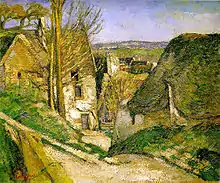Parable of the Strong Man
The Parable of the strong man (also known as the parable of the burglar and the parable of the powerful man) is a parable told by Jesus in the New Testament, found in Matt 12:29, Mark 3:27, and Luke 11:21–22, and also in the non-canonical Gospel of Thomas where it is known as logion 98[1]

Text
In Luke chapter 11, the parable is as follows:
When the strong man, fully armed, guards his own dwelling, his goods are safe. But when someone stronger attacks him and overcomes him, he takes from him his whole armour in which he trusted, and divides his spoils.
— Luke 11:21-22, World English Bible
Interpretation
In the canonical gospels of Matthew, Mark, and Luke, this parable forms part of the Beelzebul controversy, where Jesus's opponents accuse him of gaining his power to exorcise demons by being in league with Satan. Interpreted in this context, the strong man represents Satan, and the attacker represents Jesus. Jesus thus says that he could not perform exorcisms (represented by stealing the strong man's possessions) unless he was opposed to – and had defeated – Satan (represented by tying up the strong man).[2][3][4] Craig S. Keener suggests that the parable relates to the common wisdom that "no one plunders a strong man,"[5] while R. T. France and others see the parable as echoing the Book of Isaiah:[6][7]
Can plunder be taken from warriors,
or captives rescued from the fierce?
But this is what the LORD says:
"Yes, captives will be taken from warriors,
and plunder retrieved from the fierce;
I will contend with those who contend with you,
and your children I will save. (Isaiah 49:24–25, NIV)
It has been suggested that "Beelzebul" means "house of Ba'al", and that the image of the strong man's house was originally a wordplay on this.[7]
In the non-canonical Gospel of Thomas, which does not have the context of the Beelzebul controversy, the parable has been interpreted as merely suggesting that "shrewd planning and careful strategy" are necessary in order to accomplish one's goals.[8]
References
- "Gospel of Thomas (Lambdin Translation) -- The Nag Hammadi Library". gnosis.org. Retrieved 2020-08-15.
- Jürgen Becker, trans. James E. Crouch, Jesus of Nazareth, Walter de Gruyter, 1998, p. 184
- Duane Frederick Watson, The Intertexture of Apocalyptic Discourse in the New Testament, Brill Academic Publishers, 2003, p. 26
- William Telford, The Theology of the Gospel of Mark, Cambridge University Press, 1999, ISBN 0-521-43977-9, p. 62
- Craig S. Keener, A Commentary on the Gospel of Matthew, Wm. B. Eerdmans Publishing, 1999, ISBN 0-8028-3821-9, p. 364
- R. T. France, The Gospel of Matthew, Wm. B. Eerdmans Publishing, 2007, ISBN 0-8028-2501-X, p. 481
- James R. Edwards, The Gospel according to Mark, Wm. B. Eerdmans Publishing, 2001, p. 121
- Richard Valantasis, The Gospel of Thomas, Routledge (UK), 1997, p. 111